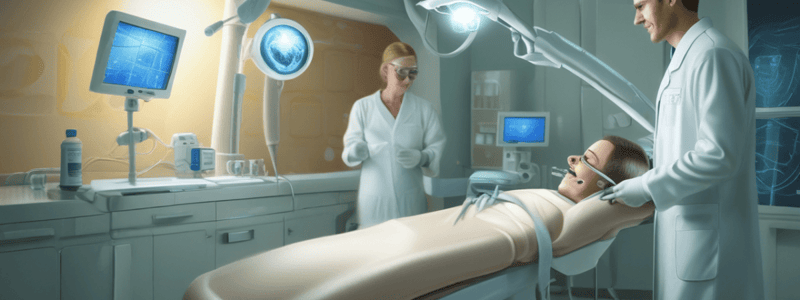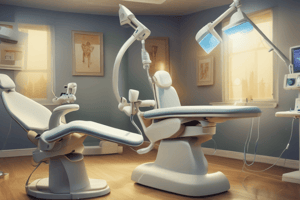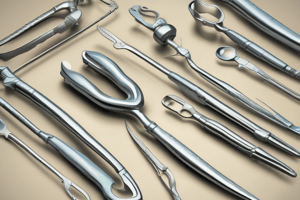Podcast
Questions and Answers
What is the wavelength range of soft-tissue lasers within the visible light spectrum?
What is the wavelength range of soft-tissue lasers within the visible light spectrum?
488 nm, 515 nm, to 535 nm
What are the wavelengths of near-infrared soft-tissue lasers?
What are the wavelengths of near-infrared soft-tissue lasers?
810 nm, 940 nm, 980 nm, and 1064 nm
What type of laser light was originally used in laser fluorescence systems for detection of dental caries?
What type of laser light was originally used in laser fluorescence systems for detection of dental caries?
Visible blue light from the argon laser
What is the advantage of laser fluorescence in detecting dental caries in pits and fissures?
What is the advantage of laser fluorescence in detecting dental caries in pits and fissures?
What type of laser is used to elicit fluorescence from bacterial deposits in carious lesions?
What type of laser is used to elicit fluorescence from bacterial deposits in carious lesions?
In what setting is argon laser-induced fluorescence particularly valuable?
In what setting is argon laser-induced fluorescence particularly valuable?
What is a potential application of using the carbon dioxide laser in early fissure caries?
What is a potential application of using the carbon dioxide laser in early fissure caries?
What was the outcome of using the Er: YAG laser to prepare holes in enamel and dentine without water-cooling?
What was the outcome of using the Er: YAG laser to prepare holes in enamel and dentine without water-cooling?
What is the benefit of using dyes in conjunction with laser fluorescence in approximal surfaces?
What is the benefit of using dyes in conjunction with laser fluorescence in approximal surfaces?
What is the appearance of ablation craters on the surface of enamel after cavity preparation with the Er: YAG laser?
What is the appearance of ablation craters on the surface of enamel after cavity preparation with the Er: YAG laser?
What is the difference in the cavity margins of dentine after cavity preparation with the Er: YAG laser?
What is the difference in the cavity margins of dentine after cavity preparation with the Er: YAG laser?
Why is the Er: YAG laser effective in removing carious material?
Why is the Er: YAG laser effective in removing carious material?
What is the primary advantage of using the Er: YAG laser for caries removal?
What is the primary advantage of using the Er: YAG laser for caries removal?
How does the ablation threshold of healthy dentine compare to that of carious dentine?
How does the ablation threshold of healthy dentine compare to that of carious dentine?
What is the effect of the Er: YAG laser on gold crowns, cast restorations, and ceramic materials?
What is the effect of the Er: YAG laser on gold crowns, cast restorations, and ceramic materials?
What is the significance of the micro-explosions produced during hard tissue ablation by the Er: YAG laser?
What is the significance of the micro-explosions produced during hard tissue ablation by the Er: YAG laser?
Why should the Er: YAG laser not be used to ablate amalgam restorations?
Why should the Er: YAG laser not be used to ablate amalgam restorations?
How does the vibration associated with the Er: YAG laser treatment compare to that of bur treatment?
How does the vibration associated with the Er: YAG laser treatment compare to that of bur treatment?
What is the potential advantage of microirregularities on the enamel surface in terms of adhesion?
What is the potential advantage of microirregularities on the enamel surface in terms of adhesion?
Why is adhesion to dental hard tissues after Er: YAG laser etching inferior to that obtained after conventional acid etching?
Why is adhesion to dental hard tissues after Er: YAG laser etching inferior to that obtained after conventional acid etching?
What is the effect of argon laser radiation on the surface chemistry of enamel and root surface dentine?
What is the effect of argon laser radiation on the surface chemistry of enamel and root surface dentine?
What is the advantage of argon laser curing compared to conventional quartz tungsten halogen lamp units in terms of temperature increase?
What is the advantage of argon laser curing compared to conventional quartz tungsten halogen lamp units in terms of temperature increase?
What is the role of camphoroquinone in light-cured dental restorative materials?
What is the role of camphoroquinone in light-cured dental restorative materials?
What is the common dental complaint that can be treated with lasers?
What is the common dental complaint that can be treated with lasers?
What is the primary goal of laser bleaching in dentistry?
What is the primary goal of laser bleaching in dentistry?
How does laser irradiation of dental hard tissues affect their susceptibility to acid attack and caries?
How does laser irradiation of dental hard tissues affect their susceptibility to acid attack and caries?
What is the advantage of using an Er: YAG laser in treating hypersensitive dentine compared to conventional desensitizing systems?
What is the advantage of using an Er: YAG laser in treating hypersensitive dentine compared to conventional desensitizing systems?
What is the potential application of lasers in preventing caries?
What is the potential application of lasers in preventing caries?
What is the effect of laser irradiation on the acid resistance of enamel surfaces?
What is the effect of laser irradiation on the acid resistance of enamel surfaces?
Why is the ongoing evaluation of lasers in hard tissue applications important in treating dentinal hypersensitivity?
Why is the ongoing evaluation of lasers in hard tissue applications important in treating dentinal hypersensitivity?
Flashcards are hidden until you start studying




